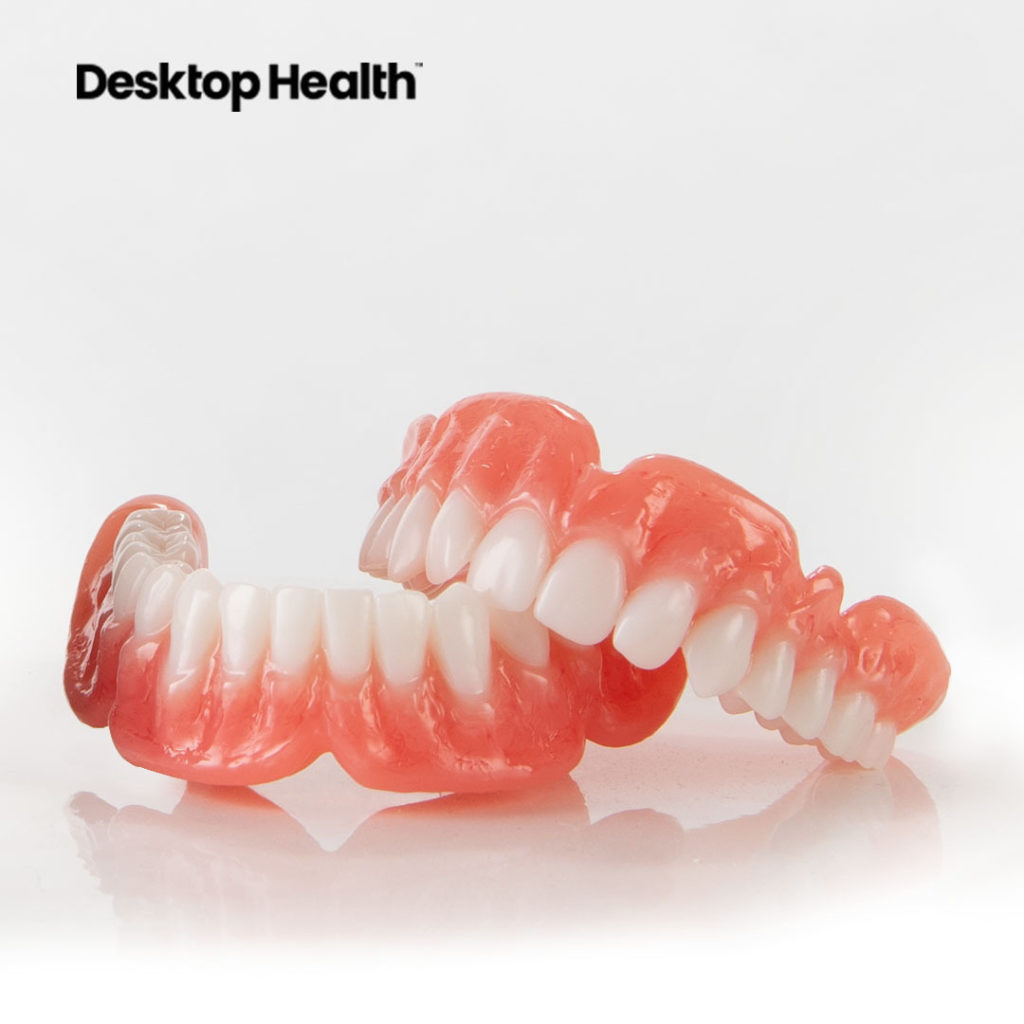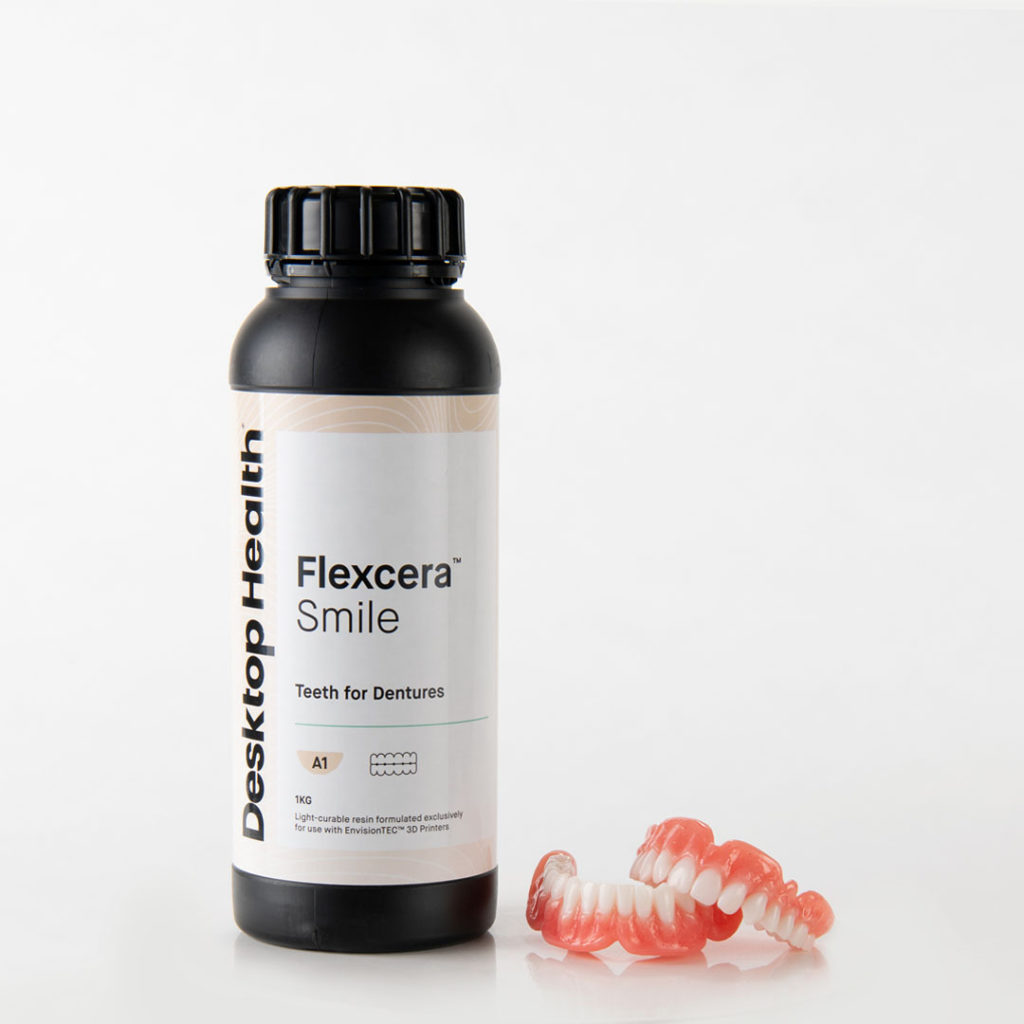Desktop Metal’s (NYSE: DM) recently launched medical division, Desktop Health, has just earned its first major pedigree as a new business unit: FDA clearance. Desktop Health’s proprietary resin, Flexcera Base, has received U.S. Food and Drug Administration (FDA) 510(k) clearance so that it may now be used to 3D print dental prosthetics.
According to the company, this product has been in development for the past three years, surely under EnvisionTEC, the DLP 3D printing inventor acquired by Desktop Metal earlier this year. The material is meant to combine the strength of ceramic with the “long chain chemistry to ensure optimal denture properties.” This means that it has three times greater resistance to fracture than some other resins on the market, as well as two times more resistance to staining or discoloration. Desktop Health claims that EnvisionTEC 3D printers can 3D print eight Flexcera dentures in under two hours.
“Three years ago, we set out to create a product that addressed the limitations of current 3D printed dental prosthetics – brittleness and poor aesthetics,” said Michael Jafar, President & CEO of Desktop Health. “The introduction of Flexcera marks the inception of a remarkable new era in dentistry, combining advanced Flexcera science with 3D printing technology to deliver superior strength, aesthetics, and function for patients. We are pleased to bring this innovative product to market as it represents our commitment to meet the needs of dental professionals and their patients.”
On its site, Desktop Health lists the competing resins as varieties from Lucitone and NextDent. The former is developed by the larger dental manufacturer Dentsply Sirona (Nasdaq: XRAY) for use on Carbon 3D printers. The latter is 3D Systems’ in-house brand. Though EnvisionTEC has always targeted the dental space with its digital light processing (DLP) 3D printers, there is a new era of competition between continuous DLP systems and materials as the technology pushed the boundaries of directly printed dental goods, such as dentures.
Desktop Health notes that the global denture market is expected to reach $3.8 billion USD by 2027, with over 36 million people in the U.S. lacking natural teeth. According to “Additive Manufacturing in Dentistry 2021” from SmarTech Analysis, 3D printing has a significant stake in this subsegment, with the total revenue opportunity for 3D printed denture components reaching around $319.8 million by 2027.
This is due in larger part to the fact that 3D printed dentures can be produced at a significantly lower price. SmarTech estimates that traditionally made dentures can cost over $1,000, while 3D printing can produce a better fitted product for just $20 in materials.
SmarTech only lists six primary 3D printer manufacturers taking advantage of this niche market, but this is sure to change in the near future. The dental space is one of the fastest growing and there will be new entrants sooner rather than later. And, as noted in SmarTech’s “Automation, Additive Manufacturing and the Factory of the Future” report, automation in the dental segment is also evolving quickly, with a number of firms introducing methods for more quickly processing 3D printed dental products. While most of this development has been dedicated to clear aligners, this is likely only the beginning for automation in the space.
“Desktop Health has changed my approach to personalized dentistry,” said Dr. Ryan Dunlop, DMD of Full Arch Masters, one of the leading experts in dental implants and digital dentistry. “The Flexcera resin delivers on the four cornerstones of why 3D printing works so well: strength, high aesthetics, accuracy and speed. With Flexcera, I am now able to deliver beautiful, high-quality and same-day dental prosthetics in record time, customized to the patient, while they are in the chair.”
The new product is being presented by Desktop Health at the LAB DAY Online Spring event taking place between May 12 and May 14. Don’t expect the new medical division to be the only 3D printing firm in attendance, as its competitors will likely be exhibiting, as well.
Subscribe to Our Email Newsletter
Stay up-to-date on all the latest news from the 3D printing industry and receive information and offers from third party vendors.
You May Also Like
Profiling a Construction 3D Printing Pioneer: US Army Corps of Engineers’ Megan Kreiger
The world of construction 3D printing is still so new that the true experts can probably be counted on two hands. Among them is Megan Kreiger, Portfolio Manager of Additive...
US Army Corps of Engineers Taps Lincoln Electric & Eaton for Largest 3D Printed US Civil Works Part
The Soo Locks sit on the US-Canadian border, enabling maritime travel between Lake Superior and Lake Huron, from which ships can reach the rest of the Great Lakes. Crafts carrying...
Construction 3D Printing CEO Reflects on Being Female in Construction
Natalie Wadley, CEO of ChangeMaker3D, could hear the words of her daughter sitting next to her resounding in her head. “Mum, MUM, you’ve won!” Wadley had just won the prestigious...
1Print to Commercialize 3D Printed Coastal Resilience Solutions
1Print, a company that specializes in deploying additive construction (AC) for infrastructure projects, has entered an agreement with the University of Miami (UM) to accelerate commercialization of the SEAHIVE shoreline...
































